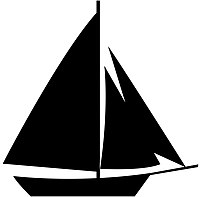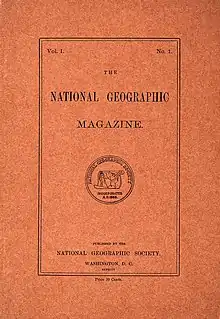Charles H. Marshall (pilot boat)
The Charles H. Marshall, was a 19th-century Sandy Hook pilot boat built in 1860, as a New York pilot-boat. She was in the Great Blizzard of 1888, the same year the National Geographic came out with an article about the successful struggle made by the crew of the Marshall. The boat was named in honor of the American businessman Charles Henry Marshall.
 Pilot Boat Charles H. Marshall (Pilot boat silhouette) | |
| History | |
|---|---|
| Name: | Charles H. Marshall |
| Namesake: | Charles Henry Marshall, American businessman, art collector and philanthropist |
| Owner: | Captain Josiah Johnson, Frederick Nelson, Jonathan Wright, John L. Calvin |
| Launched: | June 20, 1860 |
| Out of service: | 1 February 1896 |
| Fate: | Sold |
| General characteristics | |
| Class and type: | schooner |
| Tonnage: | 45-tons TM[1] |
| Length: | 78 ft 0 in (23.77 m) |
| Beam: | 20 ft 0 in (6.10 m) |
| Depth: | 7 ft 0 in (2.13 m) |
| Propulsion: | Sail |
Construction and service
The new pilot-boat Charles H. Marshall, was built by Henry Steers for Captain Josiah Johnson, Frederick Nelson, Jonathan Wright and other New York and Sandy Hook pilots. On June 20, 1860, she was launched from the foot of Twelfth street, East River.[2]
On 9 July 1860, the Charles H. Marshall, made a trail trip to the Sandy Hook Lightship and back. Charles Henry Marshall of the Black Ball line, Moses H. Grinnell, Joseph Hoxle, George W. Blunt a Pilot Commissioner and others were on board as friends of Captain Johnson. A dinner was served on board with toasts and speeches were made by the quests.[3]
The boat was named in honor of Charles Henry Marshall, an American businessman, art collector and philanthropist, who presented a silver pitcher, inscribed "Josiah Johnson, from his friend C. H. Marshall," as a testimonial to his long and faithful service.[4]
The Charles H. Marshall, No. 3, was one of twenty-one New York pilot boats in 1860 that was in regular service.[5]
On 17 June 1863, during the American Civil War, Captain Frederick Nelson, of the pilot-boat Charles H. Marshall, No. 3, spoke to the captain on the fishing schooner Rose, who reported that a three-masted, three gun, schooner privateer Nantucket took two barrels of mackerel and all their pork, but did not hurt anyone. He was looking for rich men and square-rigged vessels.[6]
The Charles H. Marshall, was listed in the Record of American and Foreign Shipping from 1876 to 1900. From 1876 through 1898, she was listed as owned by the New York Pilots and her Master was Jonathan Wright. From 1899 to 1900, G. Amsinck was the owner and Jonathan Wright was still master of the boat. She was listed as 45-tons, built in 1860, 78 feet in length, 20 feet in breadth, and 7 feet in depth.[1]
On 9 October 1873, the C. H. Marshall, was one of the boats that registered in the Ocean Regatta, which was a race from Owl's Head Point around to Cape May Lighthouse in New Jersey, and back to the Sandy hook Lightship, but did not appear.[7]
Blizzard of 1888

There was an article about the Great Blizzard of 1888, by Edward Everett Hayden, that appeared in the National Geographic Society's first magazine issue on 1 October 1888.
In the Great Blizzard of 1888, boat-keeper Robert Robinson, of the Charles H. Marshall, No. 3, provided a day-by-day report. On March 10, 1888, the Marshall, left Staten Island on a cruise. When she was 18 miles from the Sandy Hook Lightship, she ran into a dense fog with snow and rain. The captain placed three oil bags hung over the side, which saved her because the oil prevented the seas from breaking. Iron bolts were put in the oil bags to keep them in the water. By March 15, the storm had passed and she was able to return to port.[8]
When the Charles H. Marshall was about 18 miles S.E. from the lightship, a dense fog shut in, and it was decided to remain outside and ride out the storm. The wind hauled to the eastward toward midnight, and at 3 A.M. it looked so threatening in the N.W. that a fourth reef was taken in the mainsail and the foresail was treble-reefed. In half an hour the wind died out completely, and the vessel lay in the trough of a heavy S.E. sea, that was threatening every moment to engulf her. She was then about 12 miles E.S.E. from Sandy Hook lightship, and in twenty minutes the gale struck her with such force from N.W. that she was thrown on her beam ends; she instantly righted again, however, but in two hours was so covered with ice that she looked like a small iceberg.[9]
John L. Calvin
_death_in_the_New_York_Tribune_on_January_29%252C_1890.png.webp)
On 28 January 1890, John L. Calvin Sr., drowned when he was trying to steer the barkentine Edward Cushing, off Highland Light into port. He slipped over the railing into the sea. Efforts to find him showed that he had drowned.
Calvin was one of the owners of the pilot-boat Charles H. Marshall. He was 72 years old and one of the oldest pilots in the service.[10]:p28
End of service
On 1 February 1896, the New York Pilots discarded sixteen sailboats and moved them to the Erie Basin in Brooklyn. They were replaced with steam pilot boats. The Charles H. Marshall, was sold for $4,000.[11] From 1899 to 1900, she was listed with owner G. Amsinck & Co. as owner and Jonathan Wright as Master.[1]
External links
References
- "Index to Ship Registers". research.mysticseaport.org. Mystic seaport. Retrieved 13 Dec 2020.
- "New Pilot Boat". New York Times. June 20, 1860. p. 8. Retrieved 2020-12-14.
- "EXCURSION ON A PILOT-BOAT". New York Times. July 9, 1860. p. 8. Retrieved 2020-12-14.
- "Marine Affairs. The Pilot-Boat Charles H. Marshall". New York Daily Tribune. July 9, 1860. p. 8. Retrieved 2020-12-14.
- Russell, Charles Edward (1929). From Sandy Hook to 62°. New York: Century Co. p. 68. OCLC 3804485.
- "Capt. Frederick Nelson". New York Times. 17 Jun 1863. p. 5. Retrieved 2020-12-14.
- Loubat, Joseph Florimond (1887). A yachtsman's scrap book: or, The ups and downs of yacht racing. New York: Brentano Brothers. pp. 41, 54, 104.
- Hillcoat, Charles H. (1919). Notes on the Stowage of Ships; Great Storm Off The Atlantic Coast. Publisher is Colonial Pub. p. 170. Retrieved 2020-12-14.
- "The Great Storm Of March 11–14, 1888". Everett Hayden. Retrieved 2020-12-14.
- Allen, Edward L. (1922). Pilot Lore From sail to Steam. New York: The United New York and New Jersey Sandy Hook Pilots Benevolent Associations.
- "Not Up To Date. Why New York Pilots Are Discarding Sailboats". The Standard Union. Brooklyn, New York. 1 February 1896. p. 7. Retrieved 8 September 2020 – via Newspapers.com.